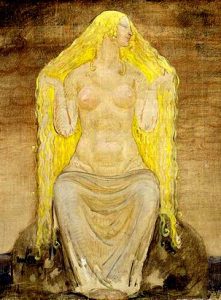Refill your flagons! Jarrod Camiré continues to bring you new material to use with Northlands: Roleplaying in Winter’s Chill. The third of four parts, this week we learn a little more about Freya.
__
In Norse mythology, Freya is the goddess of love, beauty, fertility, gold, seiðr, war, and death. She is the one who leads the Valkyries. Freya owns many fabulous objects and some fantastic animals, including the necklace Brísingamen (a unique piece of jewelry made from gold and silver that shines likes a liquid flame), a chariot driven by two cats, the boar Hildisvníi (which Freya rides when not using her chariot), and a feathered cloak that enables her to shapeshift into a falcon.
Although half of those who die in battle go to Valhalla and Odin, the other half is for Freya, who receives such valorous warriors in Fólkvangr, the Field of the Host in Asgard. This is where her hall Sessrúmnir is located. It is mostly from this place that she assists the other gods, often by allowing them to use her falcon-feathered cloak…
When her husband Odin is away, she cries tears of red gold. When such tears fall upon the trees of Midgard, they are transmuted into amber. The goddess searches for Odin under assumed names while she travels the Nine Worlds.
Names and Meanings
• Ðrungva, Drungva, or þrungva: “Longing for her Partner”
• Gefn: “The Giver” or “The Giving”
• Gullveig: “Gold-drink,” “Gold Mad,” “Gold-Power,” or “Intoxicated by Gold”
• Heidh: “Of the Heat,” “Radiant,” or “Witch”
• Heidr: “Beaming,” “Bright,” “Fame,” “Shining,” or “Splendor”
• Hörn, Hørn, Horn, or Härn: “Flax,” “Flaxen,” or “Linen”
• Mardöll, Mardoll, or Marþoll: “Sea-brightener,” “The One Shining over the Sea,” or “The One who Makes the Sea Swell”
• Mengloð or Menglod: “The One”
• Skjálf or Skjalf: “Shaker”
• Sýr or Syr: “Sow” or “The Sow”
• Thröng or Thrungva: “Throng”
• Valfreyja: “Lady of the Slain” or “Freya of the Slain”
• Vanadís or Vanadis: “The Dís of the Vanir” or “The Woman of the Vanir”
Other Names
Stemming from Old Norse Freyja (meaning lady, mistress, noblewoman, the lady, or woman), modern forms of the name include Freya, Freja, Freyia, Frøya, and Freia.
Other forms of her name are Frea, Fraying, and Ereyja.
• Freja: common Danish and literary Swedish form
• Frija: variant of Friia
• Frøya, Fröa: common Norwegian, and rural Swedish form
• Reija: Finnish form
• Freya: English form
In poetry, she has been referred to as The Daughter of Njordr, Sister of Freyr, Wife of Odr, Mother of Hnoss, Possessor of the Slain, of the Gib-Cats, of Brísingamen; Goddess of the Vanir, Lady of the Vanir, Goddess Beautiful in Tears, and Goddess of Love.
Freya is also known as The Fair One, The Seer, The Great Goddess, The Sage, Freyja of the Black Swordhand, and The Queen of the Valkyries.


I was in the Greek/Norse pantheon exchange program in high school and dated Freya for a while.
It was eons ago, but good times, good times…
Freya is not the wife of Odin. Shae is the twin sister of Frey. Frigga is Odin’s wife, goddess of marriage etc.
You are absolutely right regarding Frigga,however I’d like to mention some excerpts from Wikipedia such as:
The name Freyja ultimately means “the Lady”, from a Common Germanic *Frawjō, cognate with modern German Frau. The theonym Freyja was thus an epitheton in origin, replacing a personal name that is now unattested.The connection with and possible earlier identity of Freyja with Frigg (Frija) in the Common Germanic period is a matter of scholarly dispute.
In Norse mythology, Óðr (Old Norse for “mad, frantic, furious, vehement, eager”, as a noun “mind, feeling” and also “song, poetry”; gives “the frenzied one” or Óð, sometimes angliziced as Odr or Od, is a figure associated with the major goddess Freyja. The Prose Edda and Heimskringla, written in the 13th century by Snorri Sturluson, both describe Óðr as Freyja’s husband and father of her daughter Hnoss. Heimskringla adds that the couple produced another daughter, Gersemi. A number of theories have been proposed about Óðr, generally that he is somehow a hypostasis of the deity Odin due to their similarities.
We should also remember that the Vikings had a wife and sometimes concubines as well, so it’s possible that while Freya was not Odin’s wife she might have been at least a concubine of this god. Of course, all this is pure speculation…
This is really good stuff. Thor is probably the most popular Norse diety, and I think for different reasons in different cultures. Moderns like Thor because of the outward coolness of the Thunderer, but most old Norse probably liked him best because he was the patron god and protector of families – Mjöllnir hung over many a Viking doorway.
My favorite is Odin, because you never know what he’ll do; blessing or death, flip a coin. He’s nutty and a badass – a scary combination.
Thanks jarrod, I’m looking forward to the next installment!